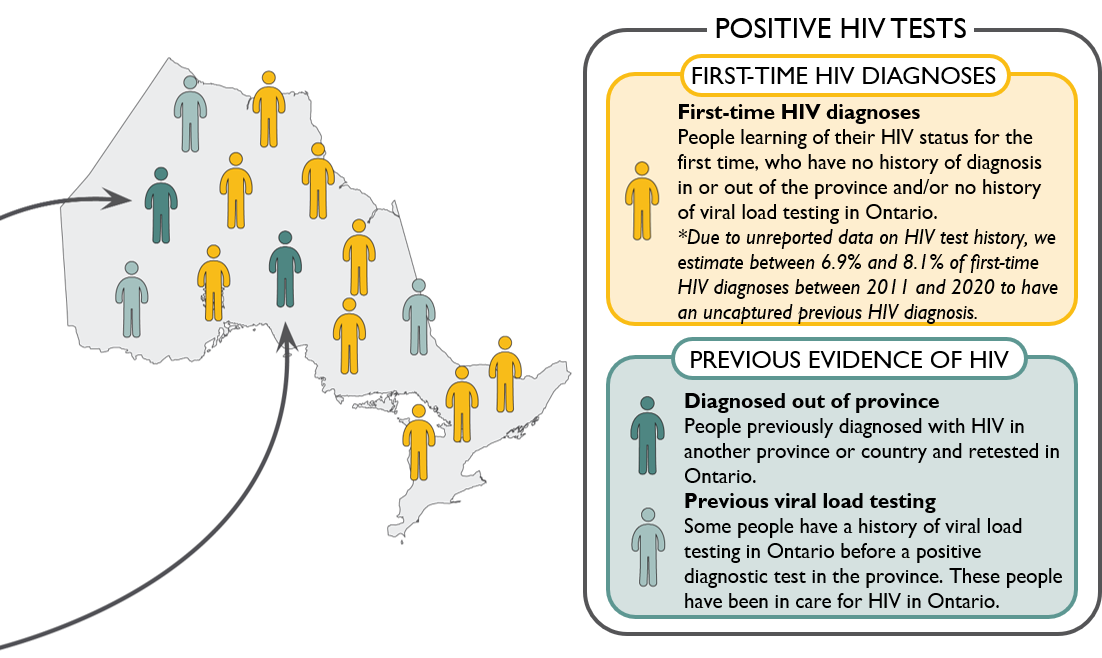Technical Notes: Positive HIV tests and first-time HIV diagnoses

OHESI distinguishes between:
- First-time HIV diagnoses – People (unique individuals) newly diagnosed with HIV, who likely reflect local transmissions (i.e. HIV infections that occurred in Ontario). First-time HIV diagnoses are our best estimate of the number of people learning their status for the first time. These are sometimes simply termed “diagnoses” for ease of description.
- People with previous evidence of HIV – People (unique individuals) who already knew their HIV status at the time of their first positive nominal (as opposed to anonymous testing) diagnostic test in Ontario. This previous evidence of HIV includes:
- People new to care in Ontario but who were previously diagnosed elsewhere (i.e. another province or country) and retested in Ontario.
- People who have been in HIV care in Ontario[1] (i.e. have a history of viral load tests) but with no previous linkable HIV diagnostic test. These individuals may have originally been tested anonymously and then retested (sometimes many years later) – perhaps when they changed health care providers. People who have evidence of a history of viral load testing before their first reported HIV positive test are counted as a positive HIV test in the first year where there is evidence of an HIV diagnosis (i.e. the year of their first viral load test).
Looking separately at first-time HIV diagnoses and people with previous evidence of HIV allows us to:
- Monitor and understand local transmissions (i.e. the current spread of the virus). It is important to understand trends in first-time HIV diagnoses to help prevention programs focus on populations in the province at greatest risk of HIV who would benefit most from prevention activities.
- Identify the care needs of all individuals who test positive each year. It is important to know the total number of people changing or entering care as well as their gender, age, race/ethnicity and region – regardless of whether they already knew their status – to plan patient-centred, culturally relevant services for all people living with HIV in the province.
It is important to note that, despite the efforts of both the new test requisition and LEP forms to collect information on previous test history for positive HIV tests, this information is still missing for a significant proportion of people. Approximately 47% of first-time HIV diagnoses in 2020 are missing data on test history either because the LEP form is not returned or it is missing data when returned. For the purposes of this analysis, any positive HIV test that did not have documentation of a previous positive on the test history section of the form was assumed to be a first-time HIV diagnosis, even though this likely overstates the number of first-time HIV diagnoses and understates the number of positive HIV tests with a previous HIV diagnosis. Using race-stratified modelling, OHESI estimates between 6.9% and 8.1% of first-time HIV diagnoses (between 5.0% and 5.9% among males and between 15.0% and 17.4% among females) have an uncaptured previous HIV diagnosis.
Note: A first-time HIV diagnosis is not the same as a new HIV infection. Many people living with HIV are not diagnosed in the same year they become infected. Trends in first-time HIV diagnoses can be influenced by factors other than infections, such as frequency of HIV testing and migration patterns, and it is difficult to disentangle these different effects.
[1] Evidence of being in care includes anyone with a history of viral load testing in Ontario of 1) more than 30 days before a first diagnostic positive test or 2) within 30 days (including same day) with a viral load <200 copies/ml before a first diagnostic positive test.
